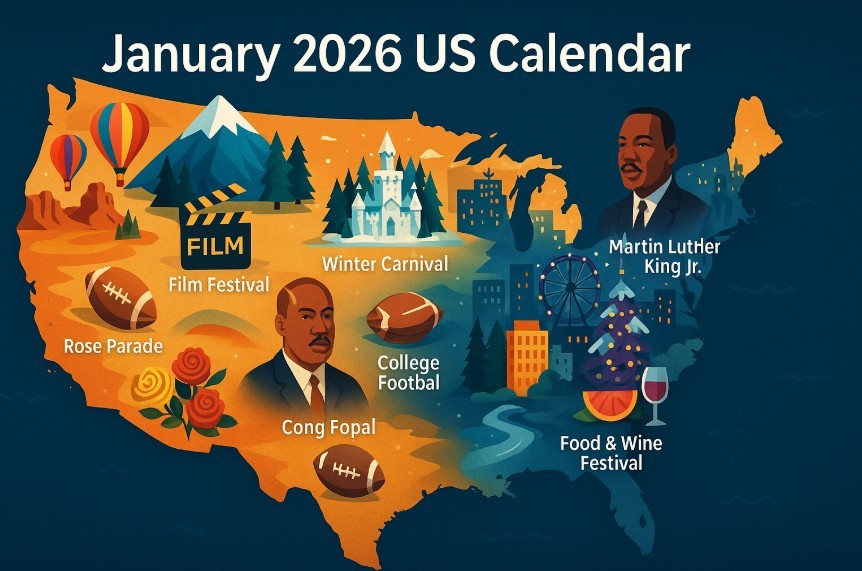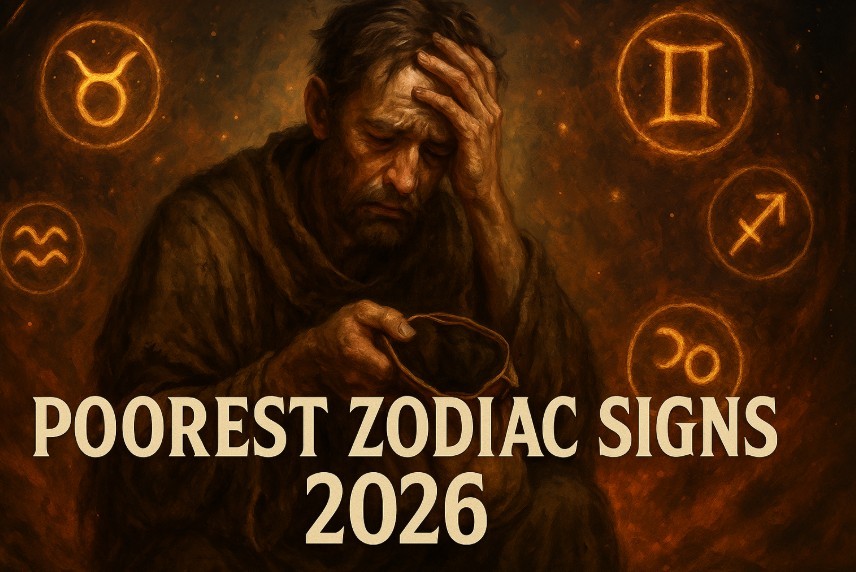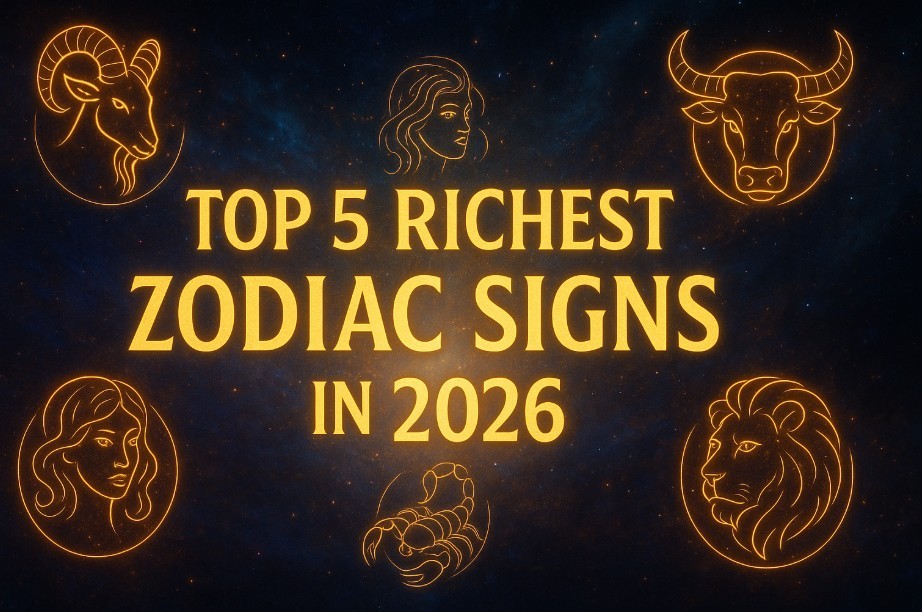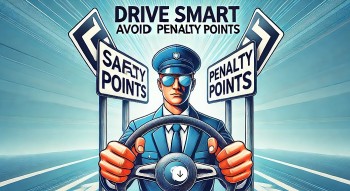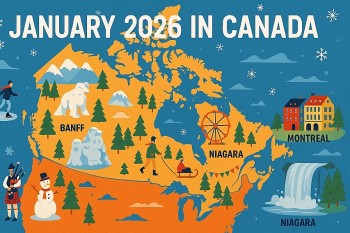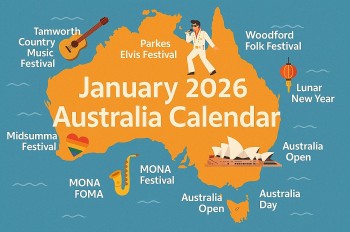Inside Trump’s Secret 28-Point Peace Roadmap: What the Draft Plan Reveals About the Future of the Russia–Ukraine War
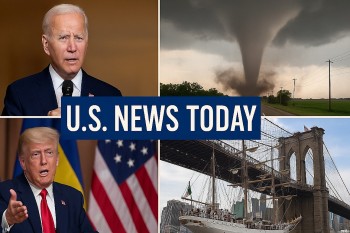 U.S. News Today | May 19, 2025: Biden Cancer, Escaped Inmates, Tornado Outbreak, And More U.S. News Today | May 19, 2025: Biden Cancer, Escaped Inmates, Tornado Outbreak, And More |
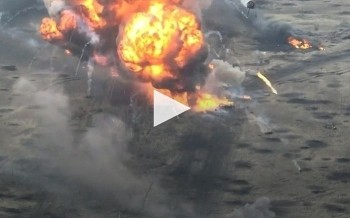 Video: Russian Iskander-M Obliterates Ukraine's Patriot 'Fire Dragon' in Dnepropetrovsk Video: Russian Iskander-M Obliterates Ukraine's Patriot 'Fire Dragon' in Dnepropetrovsk |
The long war between Russia and Ukraine may be approaching a critical turning point. New reports suggest the United States has quietly drafted and President Donald Trump has approved a 28-point peace roadmap designed to halt fighting, redraw security arrangements, and reset relationships among Washington, Kyiv, and Moscow. The plan is still confidential, but enough details have surfaced to outline its shape, its stakes, and its political shockwaves.
Although the document has not been released publicly, sources describe a four-pillar framework: ending the war in Ukraine, providing new security guarantees, recasting European security, and redefining U.S. relations with both Ukraine and Russia. The roadmap is already generating fierce debate. Supporters see a rare chance to shut down a devastating war. Critics warn it could force Ukraine into painful concessions and reward Russian aggression.
This investigation combines available reporting with geopolitical analysis to reveal the structure, logic, risks, and global implications of what may be the most consequential diplomatic proposal since the war began.
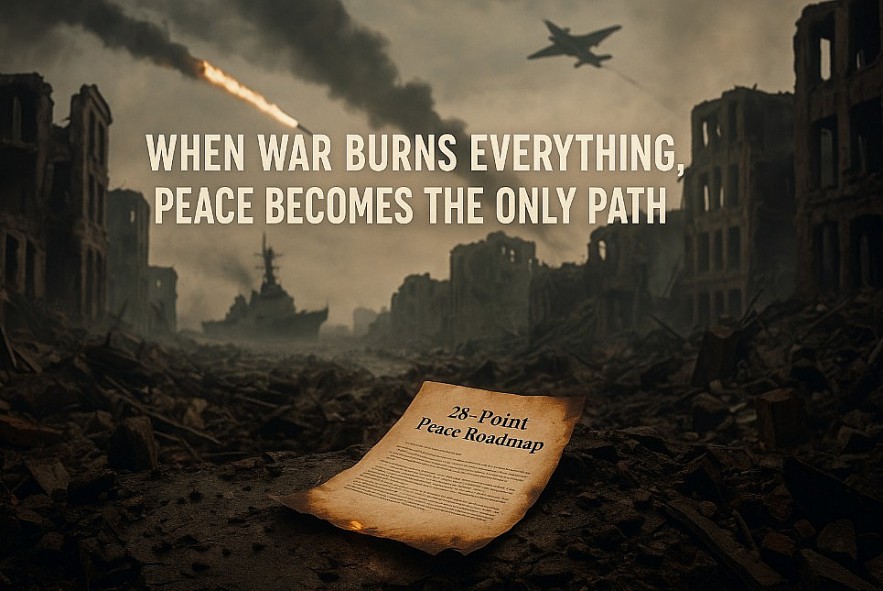 |
| When War Burns Everything, Peace Becomes the Only Path |
1. Origins and strategic backdrop
The 28-point plan did not emerge overnight. Its roots lie in several converging pressures. After years of conflict, both Russia and Ukraine faced exhaustion, mounting losses, and uncertain long-term prospects. Western support remained substantial but increasingly contested in domestic politics. A new U.S. administration with a clear desire to end the conflict quickly added further momentum toward negotiation.
Reports indicate that the plan took shape through quiet conversations among American officials, Russian intermediaries such as Kirill Dmitriev, and selected Ukrainian figures. The administration sought to craft a document that could freeze conflict, open dialogue, and offer incentives strong enough to pull both countries into talks.
Some analysts argue the roadmap echoes earlier conflict-resolution templates seen in the region. Others note similarities to Trump’s Gaza cease-fire blueprint, which also featured a structured, multiphase approach. What sets this initiative apart is its scale and ambition. It is not only a plan to end a war. It is an attempt to rewrite the strategic foundations of Eastern Europe.
2. The four pillars of the 28-point plan
Although the full document remains classified, multiple sources outline the same broad structure. Each of the four sections shapes a different dimension of the post-war landscape.
Pillar 1. Peace in Ukraine
This section addresses immediate war-ending measures. It focuses on setting conditions for a cease-fire, stabilising the front, and launching political talks.
Likely components include:
-
A phased cease-fire that starts with halting heavy weapons and moves toward complete stand-down
-
Fixing or freezing current front lines until a political decision is reached
-
Humanitarian corridors and guarantees for civilian safety
-
Early reconstruction funds to stabilise displaced communities
-
A structured dialogue on the status of contested territories
The first pillar tries to create the minimum stability needed for talks to proceed. Without this foundation, no political settlement is possible.
Pillar 2. Security guarantees
The second section is perhaps the most politically sensitive. It aims to replace Ukraine’s pursuit of NATO membership with an alternative security framework.
Likely proposals include:
-
A formal package of security guarantees from the U.S. and European allies, short of NATO membership but stronger than previous promises
-
Restrictions on some Ukrainian military capabilities to reduce Russian concerns
-
Monitoring mechanisms or peace-keeping deployments in sensitive areas
-
Long-term oversight by an international security council or joint commission
This pillar tries to reassure both sides. It offers Ukraine meaningful protection while giving Russia confidence that NATO will not expand further east.
Pillar 3. Security in Europe
Here the plan zooms out. It recognises that the Ukraine war reshaped Europe’s defence posture. The roadmap attempts to rebuild a stable strategic balance.
This pillar may include:
-
Adjustments to NATO deployments near Russian borders
-
New arms control agreements covering missiles, drones, and air defence
-
Black Sea navigation rules
-
Energy security arrangements that reduce crisis vulnerabilities
-
A formal channel for Russia, Europe, and the U.S. to discuss regional incidents
This part of the roadmap positions the settlement as a reset for European security, not a narrow bilateral deal.
Pillar 4. Future U.S. relations with Russia and Ukraine
The fourth section sets out how Washington will redefine its role. It may include:
-
A phased pathway for easing sanctions if Russia complies
-
Restoration of diplomatic channels
-
Long-term U.S. involvement in reconstruction and reform in Ukraine
-
New U.S. economic and security incentives tied to compliance by both sides
This pillar recognises that any peace settlement must include a durable American role, both as a guarantor and as a primary architect.
3. Major trade-offs inside the draft
Several high-stakes trade-offs already stand out.
Territorial concessions
Reports suggest Ukraine may be asked to accept a freeze or partial recognition of territories controlled by Russia. This is the most contentious element. Kyiv has consistently rejected giving up land, and public opinion strongly backs full territorial restoration. The draft is said to imply that peace is possible only if Ukraine agrees to negotiate the status of occupied regions.
Limits on Ukraine’s military
The plan may include restrictions on the size or type of Ukrainian forces. These could meet Russia’s long-standing demand for demilitarisation. Kyiv would see such limits as a direct threat to its sovereignty.
NATO membership deferral
A central bargain is expected: Ukraine pauses or drops its NATO ambitions in exchange for alternative guarantees. This is a red line for Moscow and a political minefield for Kyiv.
Sanctions relief for Russia
Russia seeks relief from sanctions, and the plan may offer a phased pathway tied to compliance. Critics argue this rewards aggression. Supporters say this is necessary leverage to secure Russian involvement.
Third-party enforcement
Any deal will require international monitors or peace-keepers. That raises sensitive questions about sovereignty, rules of engagement, and who controls the peace process.
4. Strategic logic: Why the plan exists
Understanding the roadmap requires seeing the incentives of each party.
Why the U.S. is driving this
-
War fatigue at home
-
Rising pressure to prioritise strategic competition elsewhere
-
Desire to establish diplomatic breakthroughs early in the new administration
-
A chance to reshape global perceptions of U.S. leadership
-
A belief that the battlefield may not produce decisive outcomes
Why Russia might consider it
-
Consolidating territorial gains through political recognition
-
Reducing economic strain
-
Securing a formal end to NATO expansion
-
Splitting Western cohesion
-
Gaining diplomatic legitimacy through U.S. negotiations
Why Ukraine faces a difficult strategic calculation
-
The war’s scale has devastated infrastructure and population
-
Aid from Western partners may face limits
-
Leaders must balance ideals with survival
-
Reconstruction requires stability
-
Rejecting talks risks prolonging a war with uncertain gains
5. Reactions from key players
Russia
The Kremlin has publicly dismissed reports but privately continues dialogue. Moscow’s strategy appears to be caution in public and assertiveness in negotiation.
Ukraine
Kyiv is wary. Any impression of surrender is politically dangerous. Ukrainian leaders insist no agreement will compromise sovereignty. Yet they are alert to the realities of an open-ended war.
United States
American officials remain tight-lipped. The administration appears to be socialising the proposal with allies while testing red lines.
European allies
Europe is split. Some capitals welcome negotiations. Others fear a settlement that weakens Ukraine or fractures NATO credibility. The plan’s third pillar directly affects Europe, which explains the strong interest and anxiety.
6. Obstacles to implementation
Ukrainian legitimacy
Ukrainian public opinion is likely to reject any plan seen as a territorial loss. Without broad support, the government cannot accept the roadmap.
Russian compliance
Russia must be willing to stop aggression and abide by verifiable rules. The track record is not reassuring.
Guarantee enforcement
Guarantees must be credible. If Western states offer strong protection on paper but weak resolve in practice, the agreement collapses.
Alliance cohesion
The settlement will test NATO unity more than any event since the Cold War. Disagreements among allies could weaken the entire framework.
The risk of territorial freeze
A freeze may lock in Russian gains permanently. Critics argue this hands Moscow a partial victory without accountability.
Timing
The war continues even as talks are discussed. Battlefield shifts can kill negotiations overnight.
7. Future scenarios
Several broad trajectories appear plausible.
Scenario 1. A balanced deal
Ukraine makes limited concessions. Russia halts aggression. Security guarantees hold. Europe stabilises. Reconstruction begins. This is optimistic but possible.
Scenario 2. A deal that fails
An agreement is signed but breaks down within months. Russia pushes again. Ukraine feels betrayed. The West loses credibility.
Scenario 3. No agreement
Talks collapse. The war escalates. Western support hardens. The conflict continues with no political horizon.
Scenario 4. A Russia-leaning settlement
Ukraine is pressured into major concessions. Russia secures long-term influence. Europe’s security weakens. This scenario carries the biggest risks for long-term stability.
8. Global implications
The consequences go far beyond Ukraine.
-
The structure of European defence could shift permanently
-
Russia’s global role may be rehabilitated or further isolated
-
Future conflicts will study this settlement as precedent
-
China and other powers will assess U.S. resolve based on the outcome
-
Energy markets and supply chains may be reshaped
-
Ukraine’s future identity, economy, and sovereignty depend on the plan’s terms
The 28-point roadmap is therefore not only a peace proposal. It is a test of the international order.
Conclusion
The 28-point peace plan approved quietly by President Donald Trump represents one of the most ambitious diplomatic efforts of the post-2022 era. It seeks not only to halt a brutal war, but to reset security structures, negotiate sovereignty, and redefine the roles of major powers. Its four pillars outline a broad framework that could either stabilise Europe or destabilise it further.
Whether the roadmap becomes a breakthrough or a failure will depend on political courage, diplomatic skill, and the willingness of all parties to accept compromise. Ukraine’s sovereignty, Russia’s ambitions, America’s leadership, and Europe’s unity all hang in the balance.
For now, the world waits for the next move.
FAQs
1. What exactly is included in the 28-point plan?
The full text is not public, but reports indicate it includes a cease-fire framework, security guarantees, European security reforms, and a reset of U.S. relations with Russia and Ukraine.
2. Does the plan force Ukraine to give up territory?
Sources suggest territorial concessions or freezes may be part of negotiations, though Ukraine has not agreed to this.
3. Would Ukraine still join NATO?
The plan likely seeks a compromise where Ukraine receives protection without formal NATO membership, which Russia rejects.
4. How would sanctions on Russia change?
A phased sanctions relief process tied to Russian compliance may be included.
5. Is the plan officially accepted by Ukraine or Russia?
No. Ukraine remains cautious, and Russia publicly downplays the reports.
6. Why is the plan controversial?
It may require Ukraine to accept painful concessions, and some argue it rewards aggression.
7. What happens next?
The U.S. is expected to consult allies and gauge political reactions before releasing any official version.
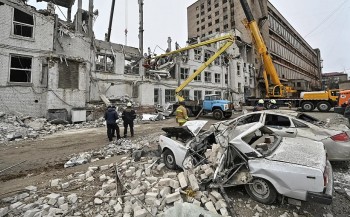 Ending Russia-Ukraine War 'This Week': Potential Scenarios and Outcomes! Ending Russia-Ukraine War 'This Week': Potential Scenarios and Outcomes! White House press secretary Karoline Leavitt made a bold statement, announcing that President Donald Trump is "confident" of brokering a peace deal to end the ... |
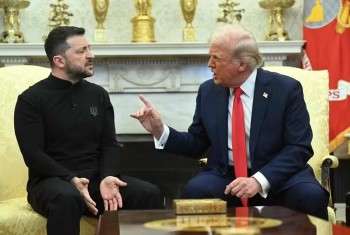 Fact-Check: Did Obama Give 'Sheets' To Ukraine? Trump's Comment During a Heated Exchange With Zelenskyy Fact-Check: Did Obama Give 'Sheets' To Ukraine? Trump's Comment During a Heated Exchange With Zelenskyy During a tense Oval Office exchange with Zelenskyy on Friday, Trump criticized Obama’s aid to Ukraine, saying he "gave sheets." He was referring to Obama’s ... |
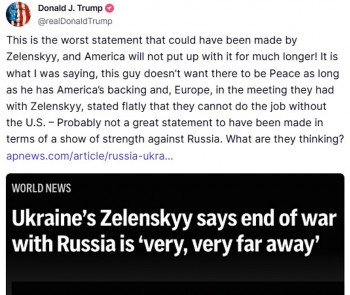 Trump Criticizes Zelenskyy's Comments on the War with Russia Trump Criticizes Zelenskyy's Comments on the War with Russia U.S. President Donald Trump has strongly criticized Ukrainian President Volodymyr Zelensky for his recent statement that the end of the war with Russia is "far, ... |
 Top 6 Richest Ukrainians in 2025: Profiles of Wealth Amid Economic Resilience Top 6 Richest Ukrainians in 2025: Profiles of Wealth Amid Economic Resilience This article delves into the profiles of these individuals, their business ventures, and the broader economic context of Ukraine. |
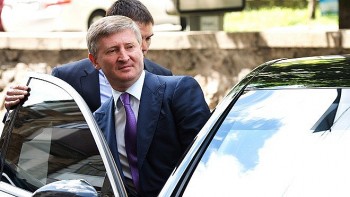 Top 5 Richest People in Ukraine 2025: Fortunes, Empires, and Power Top 5 Richest People in Ukraine 2025: Fortunes, Empires, and Power Despite the ongoing war with Russia and its severe impact on Ukraine’s economy, several Ukrainian billionaires have secured spots on the Forbes World’s Billionaires List ... |


